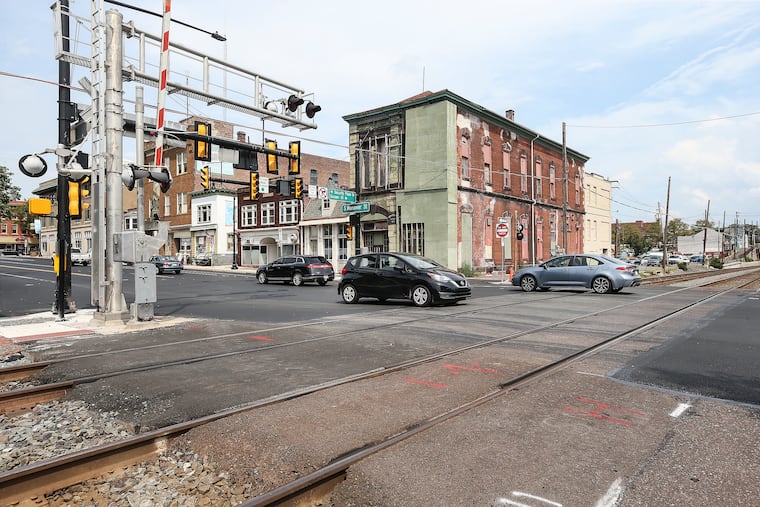Railroad crossings pose danger for drivers and trains — and navigation apps aren’t helping
At least one person a year dies in Pennsylvania at the places where train tracks and roads intersect.

Two cars had weaved between the lowered railroad crossing gates in Lansdowne and come through safely.
The maneuver, while illegal, seemed safe. A southbound SEPTA train had already passed, and the gates seemed to be staying down longer than needed. So a third driver ventured onto the tracks, and that’s when a train heading the opposite direction reached the intersection. The car was thrown for 500 yards, and the driver killed.
The April incident was the only collision at a railroad crossing on SEPTA’s system so far this year, but last year there were four, one of them fatal. In the last five years, SEPTA has reported 10 collisions resulting in three deaths. In 2018 nationwide, there were 2,214 incidents at the intersections of tracks and roads, resulting in 263 deaths, according to the Federal Railroad Administration.
Commuter trains travel through suburban communities as slowly as 15 mph or as fast as 55 mph, officials said — more than enough speed to kill people in a vehicle on the tracks.
Beyond the potential for tragedy, the collisions disrupt public transit. A car on the tracks can seriously damage trains, even causing a derailment, and also can damage tracks and nearby equipment. Even if the train is relatively unscathed, a grade-crossing collision will almost certainly cause major delays.
“You’re at least an hour, an hour and a half, at best, before you can resume service,” said Jim Fox, SEPTA’s assistant general manager for safety. “All the trains on that line will be affected if it’s during rush hour.”
The National Transportation Safety Board thinks an app could help.
» READ MORE: SEPTA train hits car that went around lowered gates, critically injuring driver
A Politico story this month detailed railroads’ failure to get GPS navigation system providers like Google or Apple to add railroad-crossing notifications to their maps, despite a 2016 NTSB recommendation that companies add alerts about the nation’s more than 210,000 crossings. Three years later, Politico reported, only TomTom and Garmin have responded to the NTSB recommendation, which is not legally binding.
A spokesperson for Google, which along with its own maps app owns the navigation app Waze, told Politico that personnel were concerned that adding railroad-crossing alerts could overwhelm drivers with warnings, causing them to ignore critical notifications.
The FRA is working with tech companies to find ways to use navigation systems to make drivers pay attention to crossings, an agency spokesperson said.
Meanwhile, SEPTA has tried to create its own collaboration with Waze, with mixed results. The agency has 148 grade crossings on Regional Rail and two suburban trolley lines. Each workday on Regional Rail alone, more than 5,000 trains cross roads used by automobiles. Waze allows SEPTA to add notifications of those crossings to the app but won’t make them permanent. So SEPTA has made staff engage in the Sisyphean task of entering the locations of all the agency’s grade crossings onto Waze every morning.
“Waze has to automatically wipe them out after 20 to 30 hours,” Fox said. “Every day we have to reinstall.” The process can take hours.
SEPTA officials have not reached out to other navigation systems out of concern that the information it provides may not translate accurately to the companies’ maps.
NJ Transit, which reported three collisions between automobiles and trains on its Atlantic City Line since 2014 — and 43 collisions resulting in 12 deaths during the same time period on tracks statewide — also is considering a dialogue with Waze, a spokesperson said. The RiverLine between Trenton and Camden reported 14 incidents since 2014, according to FRA data. Three died in those incidents.
Amtrak’s police department contacted Google last month to request adding grade-crossing alerts to its maps but has not received a reply.
“Amtrak agrees with the NTSB, and it is disappointing to see the absence of attention given to this recommendation,” said Beth Toll, an Amtrak spokesperson.
Amtrak reported two grade-crossing incidents to the FRA in Pennsylvania since 2014, one fatal. None were reported in the same time period in New Jersey.
FRA data show 6,422 grade crossings in Pennsylvania across all railroad services and 2,202 in New Jersey.
In Pennsylvania, by far the most collisions between cars and trains happen on Norfolk Southern tracks, which reported 171 incidents in five years with eight fatalities. The freight rail carrier also has reached an arrangement with Waze, the company said Monday, that gives drivers a banner notification at the top of their smartphone if they are traveling on a route that includes railroad crossings at 63 locations in Alabama, Indiana, Georgia, Ohio, Kentucky, and Pennsylvania, in Allegheny County. A driver can choose to have the another notification come up as a car nears a crossing.
For SEPTA, vehicles typically collide with trains for two reasons. People like the Lansdowne driver attempt to weave through closed gates, thinking they can beat the train. Others mistakenly turn onto the tracks, thinking they’re on a road. Both SEPTA and companies with digital navigation systems are wary of the ways GPS systems may confuse drivers in alerting them to an approaching turn.
While rail and government officials would like companies with navigation systems to be more forthcoming, they note the many existing warnings — including lights, gates, and signs — that an attentive driver should notice. SEPTA also has painted yellow stripes within the space where a vehicle would be in danger of contacting a train and is adding delineator posts at some crossings.
“There’s plenty of indications to give you an alert that there’s a grade crossing,” Fox said.